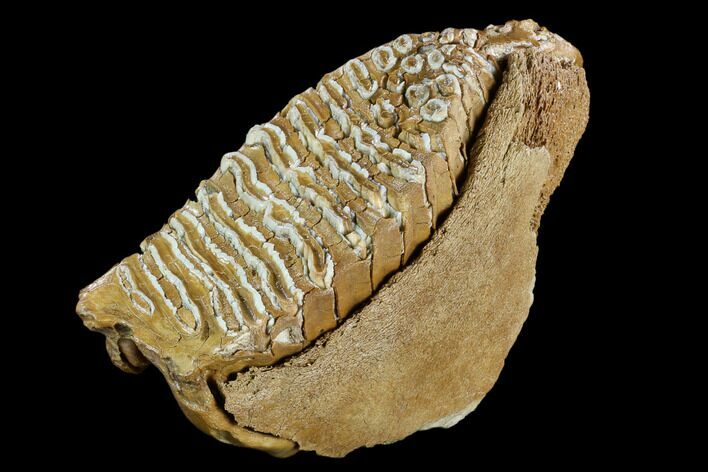This Specimen has been sold.
9.8" Fossil Woolly Mammoth Lower M3 Molar - Siberia
This is an amazing 9.8" Woolly Mammoth (Mammuthus primigenius) upper jaw, M1 molar from near Yakutsk, Siberia. This is a tooth from the Siberian permafrost and the incredible preservation shows wear from use and the prisms (hard enamel structures), dentine and cementum are in very good condition. The roots are in very good condition and a section of jaw bone is still locked to one side of the tooth. The tooth is from the upper jaw, left side.
Siberia has produced some of the most well preserved specimens of Pleistocene animals ever found. This includes a baby mammoth that still had food in its mouth. The permafrost prevents decay and preserves most tissues, including blood cells.
Comes with an acrylic stand.
Siberia has produced some of the most well preserved specimens of Pleistocene animals ever found. This includes a baby mammoth that still had food in its mouth. The permafrost prevents decay and preserves most tissues, including blood cells.
Comes with an acrylic stand.
These Pleistocene fossils were dredged up by fishing trawlers in the the North Sea between Britain and Denmark. Fishermen routinely find mammoth teeth and many Ice Age fossils in their nets: given the chance that a fossil is accidentally gathered in a net is slim, the sea floor is probably littered with the remains of millions of animals. The cold temperatures and low-oxygen environment of the North Sea have aided in the preservation of these teeth and bones.
While these fossils have been pulled up in nets for more than a century, they used to be frequently discarded. It wasn't until the past two decades that this material has begun to be systematically collected and studied. By recording the locations of their finds and allowing scientists to make observations before the more common material is made available, much has been learned about the fauna that once roamed the land that now lies 30 to 150 feet below the North Sea waters.
You can read more information about this at the following link.
http://www.independent.co.uk/news/science/the-watery-grave-of-europes-monsters-1744973.html
While these fossils have been pulled up in nets for more than a century, they used to be frequently discarded. It wasn't until the past two decades that this material has begun to be systematically collected and studied. By recording the locations of their finds and allowing scientists to make observations before the more common material is made available, much has been learned about the fauna that once roamed the land that now lies 30 to 150 feet below the North Sea waters.
You can read more information about this at the following link.
http://www.independent.co.uk/news/science/the-watery-grave-of-europes-monsters-1744973.html
About The Woolly Mammoth
The Woolly Mammoth (Mammuthus primegenius) is an iconic Pleistocene animal. It had long, wooly hair, tusks that extended up to 9 feet, and stood about 12 feet tall. They ranged across the northern hemisphere and were one of the most abundant Pleistocene creatures, ranging from eastern Eurasia throughout most of North America. Their existence overlapped with that of humans: early cave paintings have been discovered depicting these massive mammals, and humans likely hunted them to extinction in some areas.
They are also some of the most studied prehistoric animals in part because many carcasses have bene preserved in the Siberian permafrosts, keeping skin, muscle tissues, and even their distinctive woolly hair intact. Recent genomic sequencing of chromosomal DNA in some of these preserved specimens has revealed that Woolly Mammoths are most closely related to African elephants: their chromosomal DNA is up to 99.5 percent identical.
The Woolly Mammoth (Mammuthus primegenius) is an iconic Pleistocene animal. It had long, wooly hair, tusks that extended up to 9 feet, and stood about 12 feet tall. They ranged across the northern hemisphere and were one of the most abundant Pleistocene creatures, ranging from eastern Eurasia throughout most of North America. Their existence overlapped with that of humans: early cave paintings have been discovered depicting these massive mammals, and humans likely hunted them to extinction in some areas.
They are also some of the most studied prehistoric animals in part because many carcasses have bene preserved in the Siberian permafrosts, keeping skin, muscle tissues, and even their distinctive woolly hair intact. Recent genomic sequencing of chromosomal DNA in some of these preserved specimens has revealed that Woolly Mammoths are most closely related to African elephants: their chromosomal DNA is up to 99.5 percent identical.
SPECIES
Mammuthus primigenius
LOCATION
Yakutsk, Siberia
SIZE
9.8 long, 5.8" tall, 3.6" wide
CATEGORY
SUB CATEGORY
ITEM
#123650
We guarantee the authenticity of all of our specimens.
 Reviews
Reviews














